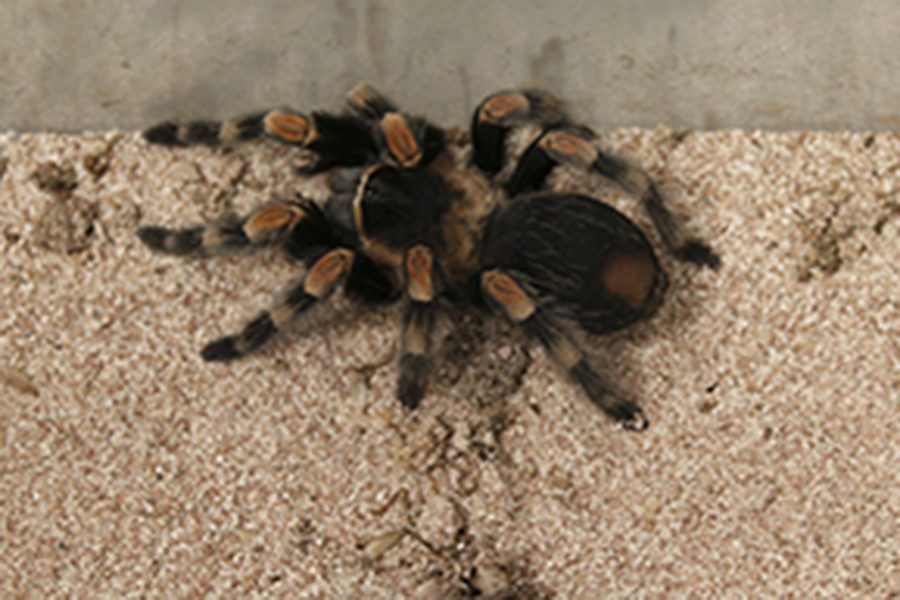Students engage with animal companions in classes to enrich learning experiences
Class pets here serve both an educational and social purpose.
Some may believe that class pets serve only to be gazed at for students’ entertainment. However, class pets here serve both an educational and social purpose.
Mrs. Susan Mills, human anatomy and physiology and zoology teacher, said, “(I have a) veiled chameleon. His name is Waldo, and I got him two years ago from Ella Hicks (’15). They didn’t want him anymore, and they wanted to know if I wanted him, so I took him.”
Mills said, “I use him in the zoology classes when we do the reptile unit. We bring him out and look at his various features.”
Junior Alan Johnson handled Waldo at this year’s Open House. Regarding his experience, Johnson said, “I loved it. It was a new thing for me. I volunteered to help out at Open House, and Mrs. Mills asked me if I wanted to handle Waldo.”
He continued, “It was a fun experience, and it wasn’t as bad as people thought it was. At first, Waldo wasn’t very happy and bit me a couple times, but he started to relax throughout the night.”
Mills also has always had fish in an aquarium in her classroom for students to see.
Mills said, “I come in during breaks to feed (the animals). I came in four or five times during Christmas break. My zoology class is going to be in charge of feeding (Waldo) now, but it’s mostly me (who feeds the animals). I take (Waldo) home over the summer.”
Mills said that later on this semester she will have a reindeer, baby pigs, chickens and llamas in her classroom for a day. She said, “Amazon John will bring in the reindeer and a whole bunch of other weird tropical animals.”
She said Amazon John brings in owls, vultures, frogs, snakes and other similar animals.
In this way, having pets in a classroom’s learning environment allows students to learn the lesson by interacting with the animals.
Johnson said, “I think class pets impact students in certain classes like zoology or biology. They would augment classroom experience by exposing students to the animal’s habits and environment.”
Mills said having class pets impacts students because “it makes them want to pay attention more, and they are more interested in what you’re talking about. I think most people love animals, and I just think it makes things more interesting.”
Along with Mills’ animals, the school’s dog, Finn, brings joy to students and teachers whenever they cross paths.
Johnson said, “Finn provides a lot of relaxation and stress relief. Plus, it’s always nice to see a dog in the hallway.”
Mrs. Rebecca Heger, clinical mental health counselor and caretaker of Finn, said, “It’s like having a living teddy bear around, and even when we walk down the hall just sometimes people seeing him brings a smile to people’s faces.”
Heger said Finn can provide an emotional support for students and faculty whenever they need him.
Heger said, “There’s a lot of people that come into the counseling office, and generally he’s here. A lot of people just come in and pet him and then leave. In a matter of seconds people will come in and say ‘I just need to pet the dog,’ and he’s always very happy to have anybody hug him or whatever.”
Heger said the next step with the plan for Finn is that students and Finn have trained to be able to work toward Finn sitting in on a class and just being there with students for a class period.
She said, “There will be a student who will be (Finn’s) handler so that way a teacher doesn’t have to worry about what he’s doing.”
Heger said, “(Finn will be in a class) just to kind of be there, to be a kind of comfort especially if you were taking a test or trying to think of a paper you have to write. Sometimes it’s just good to have something there that completely relaxes you and helps your brain work better.”
Heger said, “It’s amazing to watch people who are all stressed, and (Finn) picks up that stress level which is really interesting. There are some people who come in here to talk to me and he will kind of leave them alone but go lay on their feet, which is really interesting. He senses when somebody isn’t necessarily a dog person, and he’ll just kind of keep his distance.”
She continued, “I think one of the beauties of having a dog is that they’re very intuitive; it’s just the piece that we seem to miss sometimes.”
Theology teacher Mr. Matt Cannaday has hamsters in his classroom. Science teacher Mrs. Jennifer Duffin-Alexander has turtles in her classroom. Mr. Landeros has a spider. There is also a large fish tank in the library.
Class pets can offer many benefits both mentally and educationally to students and faculty.
Johnson thinks more classes should have companion animals. He said, “Class pets could allow for a good way of teaching responsibility to students.”







